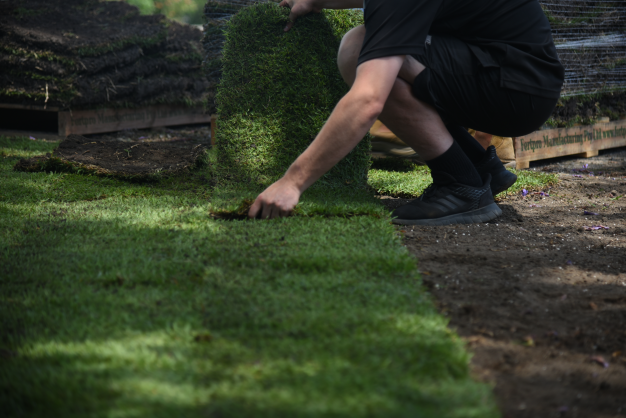How to Test & Adjust Your Soil pH Levels
If you’re looking to install a new lawn or if your lawn isn’t thriving as well as it once did, then it’s time to test your soil pH levels.
The ability of plants, particularly grasses, to absorb minerals and nutrients necessary for growth is influenced by the pH level of the soil. Most plants have a range of soil pH that makes them thrive. The optimal pH for grass is approximately between 6 & 7.

Top Tips for SOIL pH
- Keeping your lawn’s pH in balance is a key part of any lawn maintenance program
- The best time to fix your pH is before you install new turf but can still easily be done afterwards
- Testing your pH every now and then will help determine any underlying problems
What is pH?
pH stands for the ‘potential of hydrogen’ and is a scale of acidity from 0 to 14. A pH reading reveals how acidic or alkaline a substance is. More acidic solutions have lower pH and more alkaline solutions have higher pH.
Acids have a pH that is less than 7.
Alkalis have a pH that is greater than 7.
Substances in the middle that aren’t acidic or alkaline are known as neutral and usually have a pH of 7.
So, let’s look at how your soil pH affects your lawn.
When should you adjust pH Levels?
The best time to carry out any soil improvements is prior to installing your new lawn. This includes any pH adjustments that may be needed. It is quite often necessary and practical to adjust pH for existing lawns as part of a maintenance plan.
The ideal pH range for your lawn is somewhere between 6.5 and 7. Many lawn types, Buffalos in particular, have been known to do quite well in more alkaline soils up to a pH of 8. But getting closer to the neutral mark will prove more beneficial to your lawn’s performance in the long term. Basically pH affects the solubility of minerals and nutrients essential for plant growth. If your soil is out of the optimum range nutrients become difficult or almost impossible to absorb.
Measuring pH and then adjusting the levels may seem daunting, but there’s not that much really involved. Ideally, what we want is a lawn with a pH value around the neutral mark. Most Australian soil types are acidic more often than not. The process of scratching off the topsoil can expose more highly acidic clay. This will potentially affect your lawn in the long term.

How to measure soil pH
Measuring a soil’s pH is easy to do and doesn’t involve a complicated scientific experiment.
All you need is a pH testing kit and they are readily available at hardware stores and nurseries
When it comes to doing the soil test, collect a few samples from different locations around your lawn area. Mix these together to get an average reading of the whole lawn, rather than just from one location.
1. Dig down around 100 to 150 mm (4 to 6 inches) with a hand spade in a few spots. Mix up the samples in a bucket.
2. Remove any grass or root matter. Take a small amount of soil and perform the test as per the kit’s instructions.
3. Once you have the result you can look at a few ways to adjust the pH if necessary.
For a new lawn, you can spread and rake in the material directly into the soil bed. For existing lawns, you can apply water into the lawn or even cast it out by hand for smaller areas.

Correct pH imbalance
If your soil is acidic or alkaline you can add some easily obtained soil conditioners – readily available from nurseries.
Acidic Soils
Acidic soils (5.5 and below) can be helped with the application of lime or dolomite. This should be applied at a rate of approximately:
- 100 grams per square metre.
- If you have heavier loam soil use 200 grams per square metre.
- Use 300-400 grams per square metre for heavy clay soils. It’s best to apply this amount of lime over two or three applications to avoid causing any shock to your lawn.
Alkaline soils
Alkaline soils (8 and above) are a little more difficult to correct. But it is possible by adding sulphur or a sulphate such as iron sulphate or sulphate of ammonia. This should be applied at a rate of approximately:
- 25 grams per square metre for sandy soils
- 50 grams per square metre for heavier loam
- 100 grams per square metre for heavy clay soil
Carry out this process over a few weeks and test in between to get your lawn to a happy medium. Around the neutral 7 zone, your lawn will take up nutrients, minerals and trace elements more readily.

Conduct a test every year to see if anything is affecting the pH on an ongoing basis; fertilisers, water, drainage or other leaching issues.
If you’re unsure about attempting the process yourself get in touch with us here at Turfco. Getting your lawn’s pH back in balance is one of the key things before you look at a more comprehensive fertiliser regime.



